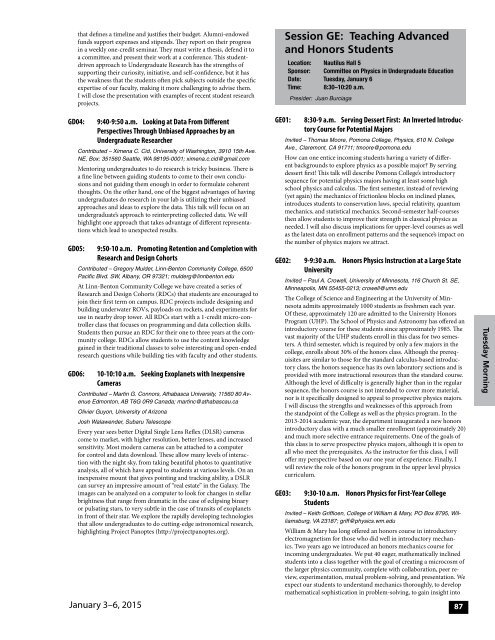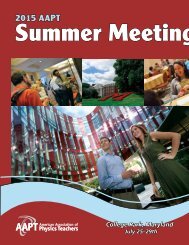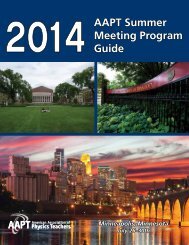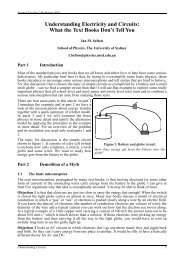final-program-12-23-14-3
final-program-12-23-14-3
final-program-12-23-14-3
You also want an ePaper? Increase the reach of your titles
YUMPU automatically turns print PDFs into web optimized ePapers that Google loves.
that defines a timeline and justifies their budget. Alumni-endowed<br />
funds support expenses and stipends. They report on their progress<br />
in a weekly one-credit seminar. They must write a thesis, defend it to<br />
a committee, and present their work at a conference. This studentdriven<br />
approach to Undergraduate Research has the strengths of<br />
supporting their curiosity, initiative, and self-confidence, but it has<br />
the weakness that the students often pick subjects outside the specific<br />
expertise of our faculty, making it more challenging to advise them.<br />
I will close the presentation with examples of recent student research<br />
projects.<br />
GD04: 9:40-9:50 a.m. Looking at Data From Different<br />
Perspectives Through Unbiased Approaches by an<br />
Undergraduate Researcher<br />
Contributed – Ximena C. Cid, University of Washington, 3910 15th Ave.<br />
NE, Box: 351560 Seattle, WA 98195-0001; ximena.c.cid@gmail.com<br />
Mentoring undergraduates to do research is tricky business. There is<br />
a fine line between guiding students to come to their own conclusions<br />
and not guiding them enough in order to formulate coherent<br />
thoughts. On the other hand, one of the biggest advantages of having<br />
undergraduates do research in your lab is utilizing their unbiased<br />
approaches and ideas to explore the data. This talk will focus on an<br />
undergraduate’s approach to reinterpreting collected data. We will<br />
highlight one approach that takes advantage of different representations<br />
which lead to unexpected results.<br />
GD05: 9:50-10 a.m. Promoting Retention and Completion with<br />
Research and Design Cohorts<br />
Contributed – Gregory Mulder, Linn-Benton Community College, 6500<br />
Pacific Blvd. SW, Albany, OR 97321; mulderg@linnbenton.edu<br />
At Linn-Benton Community College we have created a series of<br />
Research and Design Cohorts (RDCs) that students are encouraged to<br />
join their first term on campus. RDC projects include designing and<br />
building underwater ROVs, payloads on rockets, and experiments for<br />
use in nearby drop tower. All RDCs start with a 1-credit micro-controller<br />
class that focuses on <strong>program</strong>ming and data collection skills.<br />
Students then pursue an RDC for their one to three years at the community<br />
college. RDCs allow students to use the content knowledge<br />
gained in their traditional classes to solve interesting and open-ended<br />
research questions while building ties with faculty and other students.<br />
GD06: 10-10:10 a.m. Seeking Exoplanets with Inexpensive<br />
Cameras<br />
Contributed – Martin G. Connors, Athabasca University, 11560 80 Avenue<br />
Edmonton, AB T6G 0R9 Canada; martinc@athabascau.ca<br />
Olivier Guyon, University of Arizona<br />
Josh Walawender, Subaru Telescope<br />
Every year sees better Digital Single Lens Reflex (DLSR) cameras<br />
come to market, with higher resolution, better lenses, and increased<br />
sensitivity. Most modern cameras can be attached to a computer<br />
for control and data download. These allow many levels of interaction<br />
with the night sky, from taking beautiful photos to quantitative<br />
analysis, all of which have appeal to students at various levels. On an<br />
inexpensive mount that gives pointing and tracking ability, a DSLR<br />
can survey an impressive amount of “real estate” in the Galaxy. The<br />
images can be analyzed on a computer to look for changes in stellar<br />
brightness that range from dramatic in the case of eclipsing binary<br />
or pulsating stars, to very subtle in the case of transits of exoplanets<br />
in front of their star. We explore the rapidly developing technologies<br />
that allow undergraduates to do cutting-edge astronomical research,<br />
highlighting Project Panoptes (http://projectpanoptes.org).<br />
January 3–6, 2015<br />
GE01:<br />
Session GE: Teaching Advanced<br />
and Honors Students<br />
Location: Nautilus Hall 5<br />
Sponsor: Committee on Physics in Undergraduate Education<br />
Date: Tuesday, January 6<br />
Time: 8:30–10:20 a.m.<br />
Presider: Juan Burciaga<br />
8:30-9 a.m. Serving Dessert First: An Inverted Introductory<br />
Course for Potential Majors<br />
Invited – Thomas Moore, Pomona College, Physics, 610 N. College<br />
Ave., Claremont, CA 91711; tmoore@pomona.edu<br />
How can one entice incoming students having a variety of different<br />
backgrounds to explore physics as a possible major By serving<br />
dessert first! This talk will describe Pomona College’s introductory<br />
sequence for potential physics majors having at least some high<br />
school physics and calculus. The first semester, instead of reviewing<br />
(yet again) the mechanics of frictionless blocks on inclined planes,<br />
introduces students to conservation laws, special relativity, quantum<br />
mechanics, and statistical mechanics. Second-semester half-courses<br />
then allow students to improve their strength in classical physics as<br />
needed. I will also discuss implications for upper-level courses as well<br />
as the latest data on enrollment patterns and the sequence’s impact on<br />
the number of physics majors we attract.<br />
GE02: 9-9:30 a.m. Honors Physics Instruction at a Large State<br />
University<br />
Invited – Paul A. Crowell, University of Minnesota, 116 Church St. SE,<br />
Minneapolis, MN 55455-0213; crowell@umn.edu<br />
The College of Science and Engineering at the University of Minnesota<br />
admits approximately 1000 students as freshmen each year.<br />
Of these, approximately <strong>12</strong>0 are admitted to the University Honors<br />
Program (UHP). The School of Physics and Astronomy has offered an<br />
introductory course for these students since approximately 1985. The<br />
vast majority of the UHP students enroll in this class for two semesters.<br />
A third semester, which is required by only a few majors in the<br />
college, enrolls about 30% of the honors class. Although the prerequisites<br />
are similar to those for the standard calculus-based introductory<br />
class, the honors sequence has its own laboratory sections and is<br />
provided with more instructional resources than the standard course.<br />
Although the level of difficulty is generally higher than in the regular<br />
sequence, the honors course is not intended to cover more material,<br />
nor is it specifically designed to appeal to prospective physics majors.<br />
I will discuss the strengths and weaknesses of this approach from<br />
the standpoint of the College as well as the physics <strong>program</strong>. In the<br />
2013-20<strong>14</strong> academic year, the department inaugurated a new honors<br />
introductory class with a much smaller enrollment (approximately 20)<br />
and much more selective entrance requirements. One of the goals of<br />
this class is to serve prospective physics majors, although it is open to<br />
all who meet the prerequisites. As the instructor for this class, I will<br />
offer my perspective based on our one year of experience. Finally, I<br />
will review the role of the honors <strong>program</strong> in the upper level physics<br />
curriculum.<br />
GE03: 9:30-10 a.m. Honors Physics for First-Year College<br />
Students<br />
Invited – Keith Griffioen, College of William & Mary, PO Box 8795, Williamsburg,<br />
VA <strong>23</strong>187; griff@physics.wm.edu<br />
William & Mary has long offered an honors course in introductory<br />
electromagnetism for those who did well in introductory mechanics.<br />
Two years ago we introduced an honors mechanics course for<br />
incoming undergraduates. We put 40 eager, mathematically inclined<br />
students into a class together with the goal of creating a microcosm of<br />
the larger physics community, complete with collaboration, peer review,<br />
experimentation, mutual problem-solving, and presentation. We<br />
expect our students to understand mechanics thoroughly, to develop<br />
mathematical sophistication in problem-solving, to gain insight into<br />
87<br />
Tuesday Morning






